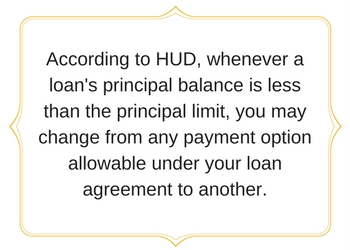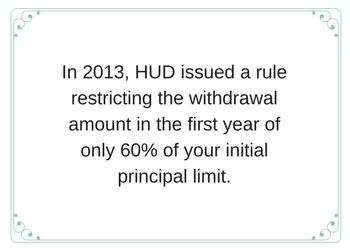Articles in Part 2 of this comprehensive reverse mortgage guide have reviewed how much money can be borrowed through a reverse mortgage, discussed borrowing limitations and explained the impact a credit rating has on loan terms. Now it's important to understand the different ways you can access funds from a reverse mortgage.

Those considering a reverse mortgage or home equity conversion mortgage (HECM) often have several important questions:
- How do I get my money?
- Can I change how money is made available to me?
- Can I draw out all my available equity at once?
Click on the link above to go directly to the information that you need or scroll down to review this article in its entirety.
How do I get my money?
Reverse mortgages offer several options for drawing equity out of your home:
1. Lump-sum draw. You can get a one-time lump-sum payment (as you would with a second mortgage or installment loan); this is called a "single disbursement lump sum."
Consider this option carefully. If you have a one-time credit need (e.g. you want to pay off your existing mortgage to change your cash-flow picture) and take an amount less than the maximum you qualify for, only to discover later that you need more money, you'll need to refinance your HECM with a new HECM to get access to those funds… which means re-qualifying and paying fees all over again.
If you do take the maximum but don't need all the money right away, this can run up the total cost of the loan needlessly -- your loan starts racking up interest as soon as the funds are drawn.
By design, a lump-sum disbursement option for an HECM carries a fixed interest rate.
 2. Line of Credit. You can set up a line of credit, where you draw funds as needed; this can go on for as long as funds are available to be used.
2. Line of Credit. You can set up a line of credit, where you draw funds as needed; this can go on for as long as funds are available to be used.
Since the amount you can borrow depends upon the age of the youngest borrower and the value of your home, the amount of unused funds available in a line of credit HECM can increase over time.
This occurs so that all borrowers can potentially receive the same monetary value from their HECM, whether or not they take all the funds at closing or over an extended period of time.
Simply put, the amount available to borrow under the line of credit grows over time for two reasons:
- At the outset of the loan, there is an expectation that you'll be using funds at a certain pace. This is based on the actuarial table used to determine how much you could borrow, which determines the maximum principal limit you actually can borrow.
As only a portion of available funds are used by you over time, rather than pulled all at once in a lump sum, each passing month means that the time available for you to use those remaining funds has shrunk by a month (it's as though you began your loan at a later date). As the potential term grows shorter by a month, the unused amount available in your line of credit is increased by an amount one-twelfth of the interest rate on the line of credit. Essentially, in a line of credit HECM, your principal limit is increased over time.
- The other reason is that unused portion of the line of credit grows at the "credit line growth rate," which is equal to the compounding rate.
The compounding rate is the same rate at which the principal limit and loan balance grow, which is the current interest rate plus 0.5 percent. Therefore, the amount of funds available to the borrower from a line of credit grows larger each month for as long as any funds remain.
This isn't like earning interest on an investment, but is more akin to an increasing credit limit on a credit card. Rather than that happening occasionally at the lender's discretion, as it might with a credit card, this process simply happens in HECMs by design.
Although this feature isn't unique to HECMs, it may not be exactly duplicated or even offered in a private reverse mortgage. For example, there may be a lower (or no) rate of growth for the available funds, and this limits the total funds available to the borrower over time.
How do you draw funds against your line of credit?
You must present a written request to the lender. Line of credit payments are paid to you within five business days after your lender receives a written request for funds.
3. Tenure payment. You can get a regularly scheduled payment amount sent to you (like an investment annuity). This is called a "Tenure Payment" and can go on for as long as you occupy the home, regardless of how high the outstanding balance grows.
Under the tenure option, you receive equal monthly payments as long as you maintain your primary residence in the home. You will continue to receive these payments even if the loan balance exceeds the loan's principal limit.
The term length for tenure payments is calculated by subtracting the age of the youngest borrower from 100 years. This is simply to establish an amount for the regular releases of funds. However, you will continue to receive payments even if you live past 100 years of age.
4. Term payment. You can opt to have a regular fixed dollar amount sent to you for a scheduled period of time (i.e. seven years), or have a scheduled dollar amount sent to you until available funds are exhausted. This is called a "term payment" arrangement. At the end of the term, no repayment of any borrowed funds is due, and you may remain in the home as long as you fulfill the obligations under the terms of the mortgage by paying property taxes, hazard insurance, and other property charges, and maintaining the home. No payments are due until the home is vacated or sold.
One scenario for the use of a term payment is where the homeowner you are 62 years old, want to retire and have plenty of equity available. You could take a term payment reverse mortgage for perhaps 10 years to allow your retirement assets more time to grow until required minimum distribution from an IRA is required, or perhaps until you reach the maximum payout for Social Security, currently age 70.
Under either "term" or "tenure" plans, the lender establishes monthly payments to the borrower by using the:
- Net principal limit (NPL). This is an "official" term; essentially, the value of the home, less all closing costs, MIP, repair costs and any other upfront fees and charges
- Length of the term in months
- Expected interest rate (for more information, see Reverse mortgage technical stuff)
Hybrid options. In addition to lump-sum, line of credit, tenure or term plans, there are also two "hybrid" arrangements available.
For either tenure or term choices, the borrower may choose to receive less than the maximum monthly payment allowed under the plan, in which case the remaining funds are placed into a line of credit. These are called modified tenure/line of credit and modified term/line of credit plans.
A modified tenure/line of credit plan is a combination of line of credit and scheduled monthly payments for as long as you remain in the home.
This choice provides a smaller regular disbursement of funds (tenure payment), preserving some funds that can be drawn upon in the event that a larger expense should come along (such as a medical bill, car repair, etc.). This might be useful for someone whose regular income and outgo create a deficit; the regular tenure payment may close the gap, but all the while, ready funds are available in the event of a sudden expense, such as a costly car repair.
 For example, a standard tenure plan might provide an available monthly draw of $500, which runs until the last borrower leaves the home. In a modified plan, you could select a monthly draw of just $300, which leaves behind a reserve pool of funds you can draw on as needed - and, because it is a line of credit, the unused available portion will grow over time.
For example, a standard tenure plan might provide an available monthly draw of $500, which runs until the last borrower leaves the home. In a modified plan, you could select a monthly draw of just $300, which leaves behind a reserve pool of funds you can draw on as needed - and, because it is a line of credit, the unused available portion will grow over time.
You decide how much of the available credit should be reserved in the line of credit, or you can specify a desired monthly payment and put the remainder into a line of credit.
A modified term/line of credit arrangement is a combination receiving funds for a fixed period of time (again, chosen by the borrower) with the remainder available a line of credit arrangement.
This is similar to a the tenure/line arrangement, but rather receiving smaller sums as long as you occupy the home, you instead receive them for only a set number of years. Remaining funds are available in a line of credit arrangement, where you can draw on them as needed. The U.S. Housing and Urban Development (HUD) office cautions that borrowers must take some care to avoid selecting a term payment so high as to empty all available equity, or there will be no funds available later for the credit line. However, this might be a useful option where funds are only needed to last until a certain date in the future, when the home may be voluntarily vacated.
Can I change how money is made available to me?
According to HUD, whenever a loan's principal balance is less than the principal limit, you may change from any payment option allowable under your loan agreement to another.
For private reverse mortgages, this may not be the case. If you think that you'll want to make a change to how you receive funds in a private plan, ask the lender in advance or check the terms of the contracts.
Regulations state that, at any time, a borrower may:
- Change the term of payments
- Receive an unscheduled payment
- Suspend payments
- Establish or terminate a line of credit, or
- Receive the entire net principal limit (the difference between the current principal limit and the outstanding loan balance) in one payment.
Is there a fee for changing the payment plan?
According to HUD, the lender may charge a fee not to exceed $20.00 for changing the payment plan.
Can I draw out all my available equity at once?
No, not any more. In 2013, HUD issued a rule restricting the withdrawal amount in the first year of only 60% of your initial principal limit. You might be able to extract a bit more, though; if your existing mortgage is more than 60% of your available amount, you can take out enough to pay off your mortgage (and any other required payments, including upfront loan fees) plus additional cash of up to 10% of your initial principal limit. This first-year withdrawal cap applies to all HECM payout options.
Reverse mortgages offer flexibility and valuable access to cash, but it's important to understand their restrictions. Our next article outlines the parameters within which reverse mortgages and HECMs operate.
Next: Reverse mortgage or HECM restrictions
Previous: Credit rating impact on HECM and reverse mortgage terms



